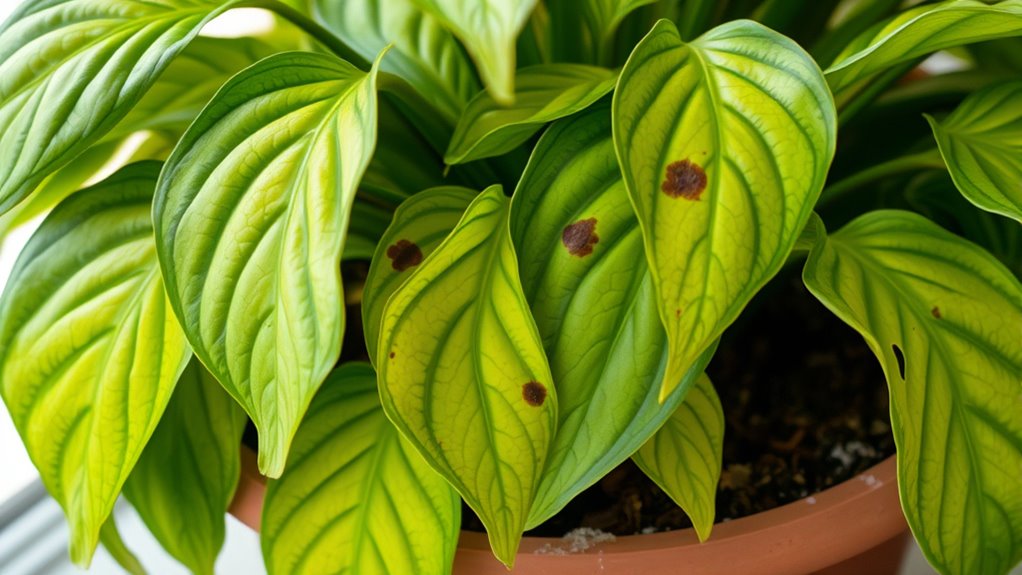If your plant shows discolored or brown leaf edges, it might be due to underwatering or low humidity. Yellowing leaves and a wilted appearance often point to overwatering, while pests like spider mites or aphids can cause sticky residue or webbing. Spotting dark spots, deformities, or holes signals possible fungal issues or deficiencies. Carefully check watering habits, inspect for pests, and adjust environmental conditions. More details can help you diagnose and fix the exact problem.
Key Takeaways
- Observe leaf color, spots, or deformities to identify signs of pests, diseases, or nutrient deficiencies.
- Check soil moisture regularly to distinguish between overwatering and underwatering issues.
- Look for webbing, sticky residue, or chewed leaves indicating pest infestations.
- Monitor environmental conditions like humidity and light to prevent stress-related problems.
- Conduct regular inspections to catch early symptoms and address problems before they worsen.

Plants can develop a variety of problems that affect their health and appearance, but many issues are recognizable once you know what to look for. When diagnosing your plant’s condition, start by examining its watering habits. Overwatering is a common mistake that can lead to root rot, yellowing leaves, and a wilted appearance. If your plant’s soil feels consistently soggy or if the leaves are turning yellow despite proper lighting, you might be watering too much. Conversely, underwatering causes leaves to become crispy, brown at the edges, and droop. Check the soil moisture by sticking your finger about an inch into the soil; if it’s dry, your plant needs water. Adjust your watering schedule accordingly, ensuring you’re providing just enough moisture to keep the roots healthy without drowning them.
After ruling out watering issues, turn your attention to pest identification. Many plant problems stem from pests, which can be tricky to spot at first. Look closely at the undersides of leaves, stems, and soil surface for tiny insects like spider mites, aphids, or whiteflies. These pests often leave behind telltale signs such as sticky residue (honeydew), webbing, or small holes in the leaves. If you notice any unusual specks or moving critters, it’s time to take action. Early detection makes pest control easier; you can start with a gentle spray of water to dislodge pests or apply insecticidal soap for more stubborn infestations. Remember, pests often thrive in dry, dusty conditions, so keeping your plant clean and well-hydrated can help prevent infestations.
Other common signs of trouble include leaf discoloration, spots, or deformities, which can signal nutrient deficiencies, disease, or environmental stress. For example, browning leaf edges might suggest low humidity or inconsistent watering, while dark spots could be fungal infections. Adjusting your care routine based on these symptoms is key. Proper lighting, watering, pest management, and occasional fertilization form the foundation of healthy plant care. Regularly inspecting your plant helps you catch problems early before they escalate, saving you time and frustration. Additionally, understanding the importance of proper nutrient intake can help prevent deficiencies that cause leaf problems. Remember, each issue has its own clues—by paying close attention to watering habits and keeping an eye out for pests, you’re well on your way to diagnosing and fixing common plant problems effectively.
Frequently Asked Questions
How Often Should I Water My Plant?
You should water your plant based on its specific needs, but generally, a consistent watering schedule works best. Check the soil moisture regularly and water when the top inch feels dry to prevent drought stress. Avoid overwatering, which can harm roots, and underwatering, which causes dehydration. Adjust your watering routine seasonally, considering factors like humidity and pot size, to keep your plant healthy and thriving.
What Type of Soil Is Best for My Plant?
Choosing the right soil is like giving your plant a tailored suit. You want soil with the right composition—mixing organic matter, minerals, and aeration components—to meet its needs. Consider drainage requirements; some plants thrive in well-draining soil to prevent root rot, while others prefer moisture-retentive mixes. Always match your soil choice to your plant’s preferences, ensuring it gets proper nutrients and water flow for healthy growth.
How Can I Prevent Pests From Attacking My Plant?
To prevent pests from attacking your plant, you should focus on pest prevention strategies that promote a healthy plant. Keep your plant clean, remove dead leaves, and inspect regularly for signs of pests. Use natural repellents like neem oil or insecticidal soap, and avoid overwatering, which can weaken your plant’s defenses. A healthy plant is less attractive to pests, so proper care is essential for pest prevention.
When Should I Repot My Plant?
You should repot your plant when it outgrows its current plant pot size or shows root bound symptoms, like roots circling the surface or emerging from drainage holes. Typically, repotting every 1-2 years helps. Choose a slightly larger pot and fresh soil to promote healthy growth. Don’t wait until the plant appears stressed; repotting proactively keeps it healthy and prevents root issues.
Are There Specific Fertilizers for Different Plant Types?
Imagine you’re in a Victorian garden, carefully tending each bloom. Just like that, you should select fertilizer types tailored to your plant’s needs. Different plants require specific nutrients, so opt for fertilizers formulated for particular types—like cactus or orchids. Using plant-specific nutrients guarantees healthy growth and vibrant foliage. Always read labels and follow application instructions to give your plants the right boost, just like a gardener from any era would do.
Conclusion
By paying close attention to your plant’s signs, you can spot problems early and take action. Remember, healthy plants thrive with proper care, so don’t ignore those warning signs. When you understand what your plant needs, it’s easier to keep it happy and thriving. Isn’t it worth the effort to become a plant detective? With a little patience and observation, you’ll turn your brown thumbs into green thumbs in no time!









